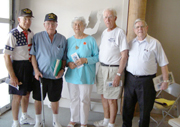 |
Burton on the Bay
By Bill Burton
|
Ten Thousand Sailors and Soldiers
How Solomons weathered the invasion
Solomons isn’t Solomons anymore.
—Alberta Woodburn
The above lines certainly would be appropriate today; Solomons isn’t Solomons anymore, what with all the emphasis in recent years on free-spending tourists. Methinks it is shaping up on the Western Shore of the Chesapeake Bay akin to what the quaint village of St. Michaels is on the Eastern Shore.
The bounty of the Bay both on Eastern and Western Shores, we are learning, is not necessarily restricted to the fish, shellfish and waterfowl, the captains and their clientele who fish commercially and for sport and the guides who carry hunting parties for ducks and geese. No, the Bay has become more of a mint churning out big bucks via visitors seeking access to the charm of Chesapeake Bay Country.
Outnumbered 15 to 1
The line Solomons isn’t Solomons anymore wasn’t written in recent years. It dates back years ago to Alberta Woodburn, who used it as a title to one of the many poems she wrote about the changes in the village and the way of life on the island where the Patuxent meets the Chesapeake.
It was in the early 1940s that Solomons, and Dowell just above it, made their initial big change. The birth of an amphibious U.S. Navy brought thousands of sailors to be trained for invasions in both the Atlantic and Pacific. At times, the 600 residents of the little village of Solomons were outnumbered 15 to one by Navy sailors and civilian and military technicians who worked on torpedoes and other explosives.
Those days were recalled recently when Calvert Marine Museum observed Cradle of Invasion, a three-day affair, highlighted by a ground-breaking ceremony for the On Watch World War II Memorial Statue at Dowell.
All Were Gentlemen
Joann Kersey, a retired Solomons elementary school teacher, was among the panelists to provide the civilian side of the arrival of the Navy on the lower peninsula. A young schoolgirl not yet in her teens at the time, she recalled coming home from class to learn that the population of her home had almost doubled during her brief absence.
The family had taken in three boarders associated with the military operation, and a young naval officer among them gave her K rations, which for kids were a collector’s item at the time. Those who stayed as time went on were Navy personnel or civilians, primarily those who tested torpedoes and land mines.
“They were all gentlemen,” Kersey said.
With three boarders, a father, mother and a sister in a five-bedroom house, things were quite busy, Kersey said, especially in the morning, as there was but one bathroom. No pity came from Vernon Garner, another panelist, who reminded her that before he went to war, his home had no indoor plumbing, just a two-seater outhouse.
Kersey recalls her mother balancing rationing stamps to feed the ever-changing boarders.
The term yippies had a different meaning back then. Yippies were charter-fishing craft taken over by the navy and painted. The government reimbursed the owners. A war was on, fuel was rationed and most citizens didn’t have much spare time, so charter fishing was in the doldrums. The boats still cruised under different skippers, and the old Gray marine engines kept humming.
Kersey said she was too young to remember much about the invasion of the Navy, but she recalled that one sailor who wanted to get from Dowell to Solomons used a large lard container as his buoyancy crossing the creek at the navy base.
Doris Johnson, daughter of the late charterboat skipper Capt. Harry Woodburn, wasn’t on the panel, but later she added her stories. Johnson attended many of the USO dances, but alas, her mother was one of the chaperones. At the peak in 1944 when 10,150 soldiers and sailors were training for the invasion of North Africa, the streets of Solomons weren’t like those in Norfolk: The sailors were too busy in their crash courses, sometimes staying only for a few weeks.
“It really wasn’t anything that different, not really new,” said Johnson. “We always had visitors, charter fishermen and those who vacationed in the big old boarding houses. We had two movie theaters. The Woodburns also took in boarders associated with the base.”
The women of Solomons were treated like queens, said Johnson, who doesn’t recall any problems associated with the invasion. “They were gentlemen. Why, only once in all that time was I whistled at.”
There was no late partying in Solomons; the last boat back to the base was at 11pm. Miss that and there was a four-and-a-half-mile hike.
Johnson fondly remembers the Navy’s sailors; she had always wanted a brother, and for a time she dated a Navy man.
What’s in a Name?
You’d think that as Solomons Island was the birthplace of the Navy’s amphibious forces, the military would be quite familiar with it. Not necessarily so.
Johnson recalled the time someone of importance in Washington tried to reach her dad via phone, ordering that he be connected with Capt. Harry Woodburn of Solomons Island. He was informed there was no Capt. Harry Woodburn at Solomons Island.
By the time it all got straightened out, it was learned the call was first directed to the Solomons Island in the Pacific, site of one of the great battles of the war.
The way our Solomons Island is growing these days, small chance that confusion will reoccur.